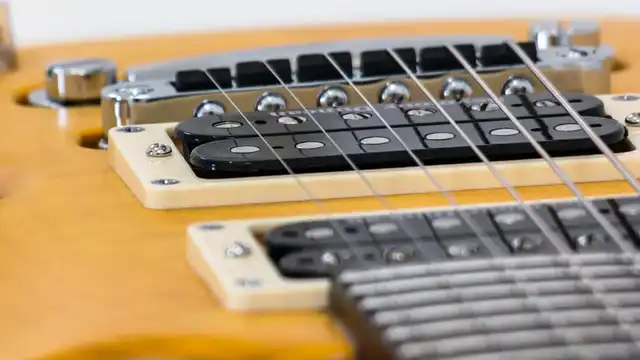We Put 17 Gauge Strings on an Electric Guitar...


Be sure to subscribe to our YouTube channel to keep up with more great videos like this one.
Transcription
As I've mentioned before, we have players that play everything from sevens up to things like 19s, or sometimes even heavier for very specific uses. Would I recommend the extremes of those to everybody? No, probably not... But extremely heavy gauges do have their uses. And moreover, I want to show you today that it's possible to put really strange gauges on your guitar without necessarily causing any damage—or at least I don't think it's going to cause any damage. I haven't put a set of 17s on this guitar before...The Gameplan
So the custom guitar string set that we're gonna be putting on today in order goes .017 - .022p - .030 - .040 - .052 - .064 Now, each of these gauges tuned to standard would exhibit somewhere north of 40 lbs of tension on the neck, which is a lot of tension for an electric guitar. Typically, we'll see anywhere between 12 lbs and 16 lbs in the .009 to .010 gauge range for most electric guitars. So 40 lbs is quite a bit, but it's not necessarily unheard of. Most bass guitars at 34-inch scales are gonna have around 44-45 lbs of tension on each individual string. So it's not necessarily an extreme, but it's a lot more than you typically see. As far as tuning goes, I'm going to play around a little but and see what I can tune it up to before it starts to feel a little bit too tight. In general, a set of 17s is gonna have the same amount of tension when it's tuned to G standard as a set of 10s will in E standard.How bad is it for your neck?
There's a pretty common myth that people have that heavier strings are necessarily exhibiting more tension on the neck of your guitar than lighter strings, but it all depends on your tuning. If you're tuning down to accommodate the heavy gauge strings, you're not necessarily going to have any more tension on your neck than you will with a light gauge set at standard. So without further ado, let's get this set of 17s on. I'm not sure exactly how it's gonna go. I'm gonna mess around with it a little bit and get it all set up so it's kind of playing decently. I think right now I have a set of 12s or something similar on here. So it's gonna be a little bit of an adjustment, but we'll see what happens. (...changing strings...)What does it play like?
All right, so we have that .017 through .064 set popped on this 339 right now, and it sounds pretty awesome. I messed around with a few different tunings when I was playing with it. I think B standard—I've actually got it in open B, because that's what I typically play in—is kind of the logical home for it, where I've got a bit of tension but it's not too much. We could throw it in E standard, but it would just be extra, extra tight. But in B, even at this 24.75-inch scale, we've got a pretty wild growling sort of baritone tone. I'm going to put on some drive because it's a little bit boring without drive when you're playing this low. I'm going to use the JDS-50 from my friend Jack Deville at Mr. Black Pedals to give us some grit. (...metal riffs ensue...) So chugging riffs are obviously the easy thing to do when you're tuned all the way down here in B. But you can do plenty else as well. (...clean riffs follow...) So you'd think it would be really tough to bend with something like 17s on here, but it's not that bad, especially if you're tuned down as low as B. Here on the highest string, I can do a normal whole step bend. But I can also even do like a step and a half without too much trouble. It's not as easy to bend as something like 9s, but it's very doable, especially with this shorter scale on this Epiphone or a Gibson style scale length.What does it sound like?
Tonally, the first things I noticed is that we have a really heavy, meaty tone—the larger diameter of all these strings is giving us a littlebitt more output through our pickups, although they're just P90s so they're not that hot to begin with. But we're definitely getting that thuddy, thunderous, sort of loud powerful tone that a lot of players that play really heavy gauge strings are famous for. In terms of playability, do we give up a lot? In my opinion, no, not too much. Sure, it's a little bit harder to bend, and it might take a little bit of getting used to. You definitely have a pretty mean third string with that 30 there. But none of it's stuff that you couldn't surmount, especially if you practice for a little while. You could probably get to where you're playing most styles this way, as long as you don't need like, two whole-step bends or anything like that.Our takeaway
So, can you put 17s on your guitar? Yeah. Absolutely. I would recommend keeping an eye on your truss rod, especially if you're tuning it up higher. That might need a little bit of adjustment. In general, going with heavier diameter strings is going to change your action as well, so if you want that just right, you'll definitely want to be able to dial that in once you go up to the gauge. But they definitely will work, and if you're keeping them into a more reasonable pitch, something like B that I have on here, it's not gonna create any more stress or trouble for your guitar than you would see otherwise. This probably strings up somewhere around how 11s, 11 1/2s, or 12s would be in standard. So it's little bit more tension, but it's not necessarily too much. Interestingly, I haven't really changed anything about my set up at all. That's mainly because I'm not gonna keep 17s on this guitar for too much longer after I get done playing with them for a little bit. But the intonation isn't terrible. It's not great either, of course, but it's not awful. My action is a little bit higher than normal, but it's not too bad. So I think the lesson there too is that you don't necessarily have to be super afraid about making, you know, even extreme jumps in gauge if you really aren't too picky about a lot of your set up stuff. Sure, if you want it perfect, you're gonna have to dial it in to be perfect, but if that's not your goal, it's not gonna cause to much trouble for you. Should you try this at home? That's totally up to you. If you do, I would recommend not doing on a super expensive guitar. Or if you are, make that you have a tech nearby or somebody that really knows what's going on so they can keep an eye our to make sure you're not gonna do any damage to the guitar. But again, if you have everything at the right tuning, you're not gonna really be causing any much more stress on your neck than you would otherwise. And, if you're like me, now you've got a baritone guitar in a 24.75-inch scale length, which I think would be a little bit of fun to mess around with, and definitely it's fun to be able to get that experience without having to spend hundreds of dollars on a new guitar. So I'm curious from you guys, what's the heaviest gauge of strings that you've put on your guitar? What'd you think of them? Leave them in the comments down below!Other Posts you may like

Guitar Strings Order: How the Guitar is Tuned and Why

Best Acoustic Guitar Strings for Beginners

Two Handed Tapping: Our Top 8 Tappers of All Time

Which Guitar Strings Wear Your Fret Wire Down More?

What is Nashville Tuning? Its History, Best Guitar Strings & Uses

Guitar Scale Length Explained: String Tension & Playability
0 Responses
Leave a Reply
Your email address will not be published. Required fields are marked *




